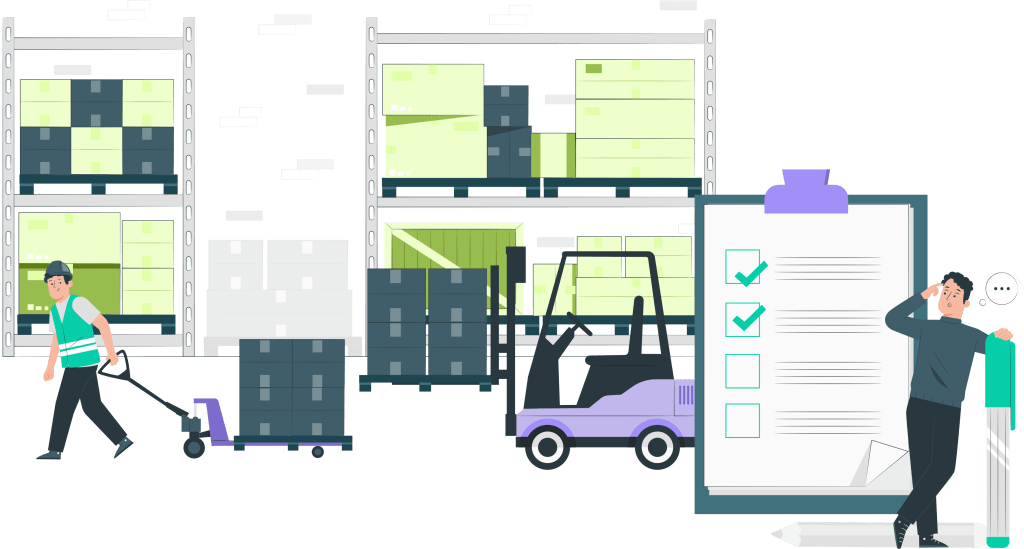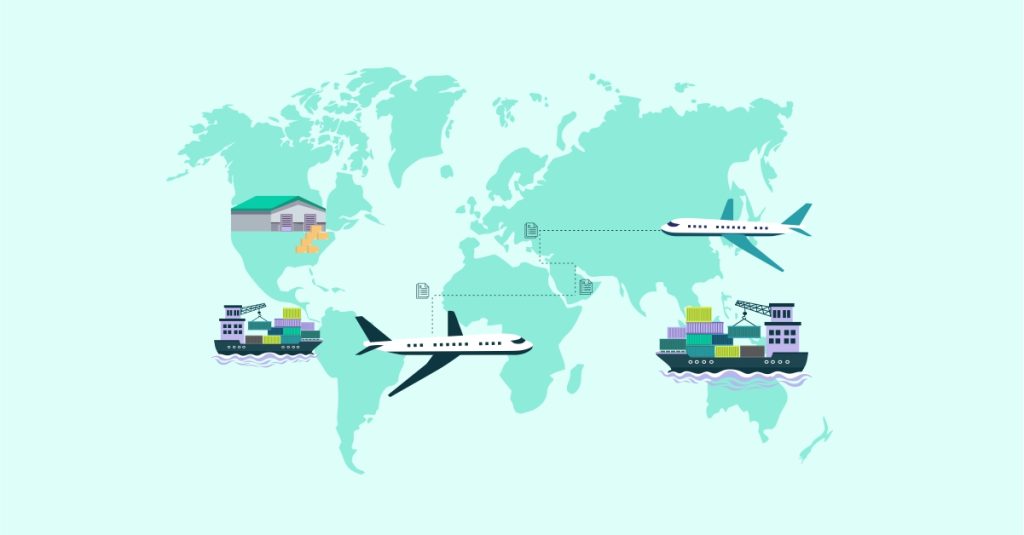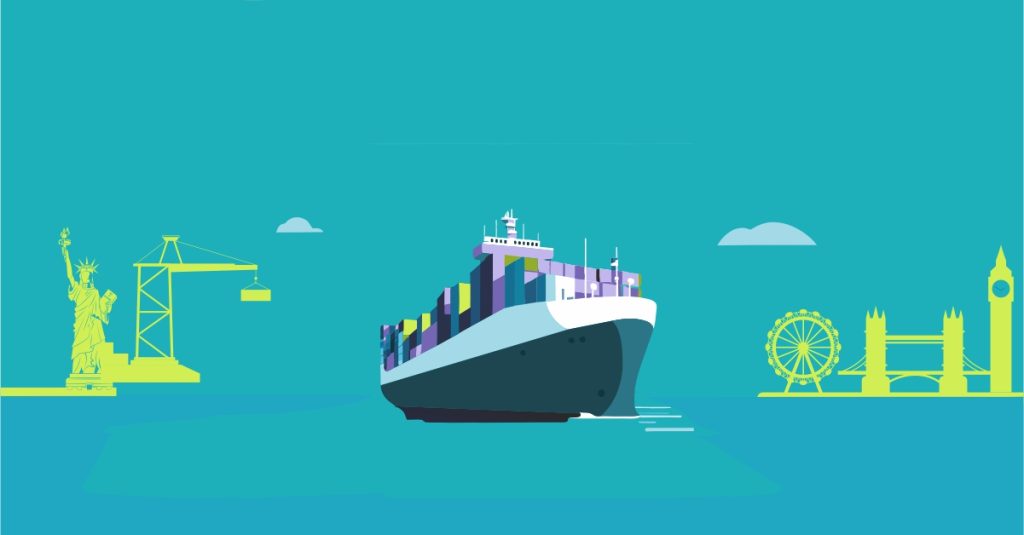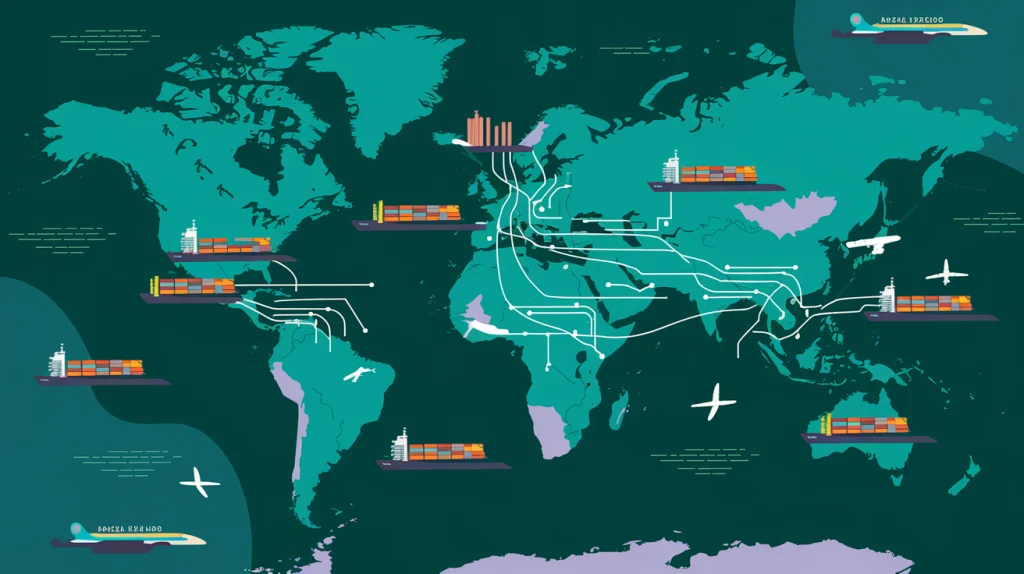Ever felt like navigating Amazon’s warehouses is a high-stakes game of global shipping chess? Selling overseas brings excitement but also tosses sellers into a shipping quagmire, with each Amazon marketplace adding a unique twist.
The real puzzle? Amazon pallet requirements for global sellers vary across regions.

Any misstep can lead to delays, surprise expenses, penalties, rejections, or damage to your reputation. Therefore, in this article, we’ll share Amazon’s preferred pallet standards and why they insist on sellers using pallets.
We’ll also help you learn the ropes for preparing pallet shipments for Amazon FBA centers and avoid instances where Amazon may reject your shipment. So, what are the pallet requirements for international shipments?
Let’s find out!
Amazon Pallet Requirements: A Quick Explainer
- Pallet dimensions vary for different regions/Amazon marketplaces.
- The maximum height of a pallet encompasses the pallet and loaded freight.
- Weight limits for single and double pallets are the same for a region.
- Sturdy wooden or plastic pallets (only in Japan) are recommended for durability during shipping.
- Follow ISPM-15 regulations or face rejection or additional fees.
- Pallets should follow GMA Standard B, GMA Standard 1A, and GMA 1B grades.
- FBA Box ID and FBA Pallet ID labels on pallets are essential for inventory tracking.
- Clear plastic stretch wrap is required for pallet visibility.
When and Why Amazon Wants Sellers to Use Pallets?
Amazon mandates using pallets for FBA (Fulfilled By Amazon) shipments that exceed 150 pounds, have 20+ individual boxes, or fill an entire truck. This is done to ensure efficient order fulfillment. LTL (Less Than Truckload) and FTL (Full Truckload) shipments are part of the FBA program requiring pallets.
LTL is a budget-friendly choice for freight weighing 150 to 15,000 pounds, with multiple shippers sharing truck space and paying only for their portion. Pallets in this type of shipment are often used to bundle smaller packages, streamlining handling and transportation.
But what is the LTL pallet limit? Sellers can simultaneously ship up to 10 pallets, no longer than 12 linear feet, for an entire LTL shipment. This provides a budget-friendly option for restocking without the hefty expenses of full shipping trucks. Just make sure there are no more than 5,000 boxes on each pallet.
FTL shipments, however, are for freight that occupies the entire truck space, weighing more than 15,000 pounds. They usually need pallets to arrange and securely transport goods. Sellers can ship up to 26 pallets in FTL. Other reasons why Amazon wants sellers to use pallets for FBA shipments include:
- Efficiency – Pallets make loading and unloading quick and easy, with swift movement using forklifts or jacking devices, reducing time and effort for handling individual boxes.
- Safety – Goods on pallets lessen the chance of damage during transit. They can be shrink-wrapped or strapped together for added protection, minimizing the risk of loss.
- Space Optimization – Pallets allow for efficient use of warehouse or truck space by easy stacking, maximizing storage capacity, and reducing storage costs.
- Cost Savings – Pallets can cut handling costs by moving more goods at once, potentially leading to faster deliveries, improved customer satisfaction, and increased sales.
- Tracking – Pallets provide traceability throughout the supply chain, aiding inventory management and offering valuable data for enhancing logistics and supply chain operations.
If you’ve been selling on Amazon for a while, check your sales history to gauge your average monthly shipping volume. Larger shipments that aren’t practical as individual units may require palletization. Also, refer to Amazon’s FBA Seller Central guidelines for your region for palletizing shipments to comply with their standards.
You can use an FBA calculator to estimate shipping costs based on product dimensions, weight, and shipping method. Or get a free quote from an Amazon FBA freight forwarder like Unicargo. We can assess your FBA shipping volume and suggest cost-effective ways tailored to your needs.
Types of Pallet and Amazon’s Preferred Pallet Standards
Storing goods on pallets in Amazon’s fulfillment centers is convenient due to their standard size, allowing efficient stacking for optimal space utilization. Moreover, Amazon’s warehouses are built to handle palletized goods, making it faster and easier to move them around. This reduces the processing time for shipments.
However, choosing the right pallet standard is crucial for secure shipping through Amazon FBA, determining whether your delivery goes smoothly or faces potential damage. But here, some questions might come to mind, like, “What pallets does Amazon accept, and what are the requirements for Amazon pallets?”
The answers are not straightforward, though. Amazon has varying pallet requirements depending on the country. As a global seller, you must adhere to the specific pallet material, grade, Amazon pallet size requirements, etc., of the destination where your pallets will be shipped. So, let’s discuss each of them in detail:
1. Pallet Type
Here are Amazon’s preferred pallet types for the US, EU, and Japan:
- US, AUS, Canada, UAE, SA, and Mexico –Global sellers Amazon pallet requirements for USA, Australia, United Arab Emirates, Saudi Arabia, and Mexico include a four-way entry or block pallet. Accessible from all four sides by a forklift, it’s perfect for tight spaces or moving pallets in various directions.
- EU – Amazon suggests using a 4-way access EURO/CHEP pallet for Europe. This type is tailored to meet the European Pallet Pool (EPP) and Chemical Distribution Association (CHEP) standards, commonly employed for transporting goods across Europe.
- Japan – Amazon has four pallet standards for Japan. One is the four-way access one, while the other three include 1-way fork and 2-way fork pallets and one-sided pallets.
One-way pallets are meant for single-use when shipping goods. They come in various shapes and sizes as they lack standardization. On the other hand, two-way pallets, also known as stringer pallets, are designed for lifting by the deck boards, featuring openings at the top and bottom.
Two-way pallets are cost-effective, beneficial for businesses shipping large volumes, and allow lifting from both front and rear.
In contrast, one-way pallets have a continuous sheet without gaps. This makes them easy to clean and ideal for transporting small items without the risk of them slipping through the cracks.
| Amazon’s Preferred Pallet Type for Different Regions | ||
| US, AUS, Canada, UAE, SA and Mexico | EUR | JP |
| 4-way entry or block pallet | 4-way access EURO/CHEP pallet | 4-way access, 1-way fork, 2-way fork, and one-sided pallets |
2. Pallet Material
Amazon mandates using ISPM -15 wooden pallets (lumber, plywood, composite, etc.) for the US and EU and most of the other marketplaces. ISPM-15 wooden pallets undergo heat treatment or fumigation to meet the International Standards for Phytosanitary Measures (ISPM) No. 15.
This global standard aims to prevent the spread of pests and diseases by regulating the treatment of wood packaging material. Furthermore, the International Plant Protection Convention (IPPC) governing ISPM-15 has made it compulsory for heat-treated pallets to bear their approval stamp.
In specific cases like Japan, plastic pallets (polypropylene) are also acceptable.
3. Pallet Size
So, what size are Amazon pallets? Amazon has different standards for pallet size according to the countries:
- US – A single pallet should be 40 x 48 inches or 101.6 X 122 cm in dimensions. But are there any weight or size restrictions for shipping pallets to Amazon FBA US? Yes, there are. A solo pallet shouldn’t exceed 72 inches or 182.5 cm in height, counting the pallet’s height.
If a single unit adheres to clamping instructions, it can reach up to 98 inches, including the pallet’s height. Whereas stacked pallets can’t surpass a combined height of 100 inches or 254 cm (50 inches per pallet stack).
Here, 45 inches is for boxes, and 5 inches is for the pallet. For shipping single and double pallets in the US, the maximum weight should be at most 1500 lbs or 680 kg.
- EU – Amazon recommends 80 X 120 cm of pallet dimensions; the max height should be 180 cm for a single pallet in Europe. For the UK, the measurements should be 100 X 120 cm. However, double pallet height differs in different regions of Europe.
It’s 270 cm in Germany, Central, and Eastern Europe, and 300 cm for France, Italy, and the UK. But wait! What is the maximum weight for a pallet on Amazon in the EUR? The total weight of the pallets shouldn’t exceed 500 kg in all of Europe.
- Japan – Amazon FBA pallet requirements for Japan are 110 x 110 cm in dimensions, except for beer deliveries. The height for a single pallet, including cartons, should not go beyond 1.6 meters (160 cm), but for the NRT1 warehouse (located in Ichikawa city), it’s 150 cm.
And what is the maximum weight for a pallet on Amazon for the Japanese marketplace? Amazon advises using pallets with the total weight not surpassing 1000 kg and a minimum height of 20 cm.
- AUS – Amazon Australia accepts both Australian standard pallets (116.5 cm x 116.5 cm) and GMA pallets (121 cm x 101 cm) for FBA shipments. The pallet weight should not go over 680.4 kg.
Single pallets can’t be taller than 180 cm (except for BWU1 and MEL5 warehouses, where the limit is 160 cm). While double-stacked pallets must not exceed 254 cm in height, and they shouldn’t be stretch-wrapped together.
- Canada – Amazon FBA in Canada takes GMA pallets with dimensions of 100 x 125 cm. Single pallets shouldn’t be over 175 cm tall, including the pallet. Double-stacked pallets must stay under 250 cm in height, including the pallet. The total weight of the pallet must not go beyond 675 kg.
- UAE & SA – Both Amazon UAE & Saudi Arabia accept 100 x 120 cm pallets with a maximum gross weight of 500 kg. For shipping boxes sold together weighing over 50 kg, place them on a single pallet (one unit on each) or clamp them together. Single pallets can be 160 cm high, including the pallet. While double-stacked pallets must not go over 270 cm in height.
- Mexico – Amazon Mexico mandates 100 x 120 cm pallets, but only single-stacked pallets are allowed, no doubles. Besides, single pallets must not exceed 180 cm in height or 726 kg in weight.
| Amazon’s Preferred Pallet Size for Different Regions | |||||||
| Pallet | US | EUR | Japan | AUS | Canada | UAE & SA | Mexico |
| Max Dimensions | 101.6 x 122 cm | 80 x 120 cm, 100 x 120 cm (only UK) | 110 x 110 cm | 116.5 x 116.5 cm, 121 x 101 cm | 100 x 125 cm | 100 x 120 cm | 100 x 120 cm |
| Max Height | single pallet 182.5 cm, double pallet 254 cm | single pallet 180 cm, double pallet 270 cm (Central & Eastern Europe, Germany), double pallet 300 cm (Italy, UK & France) | single pallet 160 cm, NRT1 warehouse 150 cm | single pallet 180 cm, BWU1 and MEL5 160 cm, double pallet 254 cm | single pallet 175 cm, double pallet 250 cm | single pallet 160 cm, double pallet 270 cm | single pallet 180 cm, double pallet not allowed |
| Max Weight | 680 kg | 500 kg | 1000 kg | 680.4 kg | 675 kg | 500 kg | 726 kg |
4. Pallet Grades
Amazon only accepts pallets that fulfill Grocery Manufacturers Association (GMA) standards, and there are three types of these standards. They are GMA Standard B, GMA Standard 1A, and GMA 1B pallets. GMA pallets are recycled pallets, and their grades help assess their rate based on their condition and repair status.
- GMA 1A – Also called Premium Grade A pallets, these pallets are of top-notch quality, in premium condition, and are used for transporting delicate items. They excel in transporting groceries, health, personal care, and beauty products to stores and are even used for in-store food displays.
- GMA 1B – GMA 1B Grade pallets, also known as Melon Grade, are generally of similar quality as GMA 1A Grade pallets. But they may have some cosmetic damage, like minor scratches or discoloration however, no heavy sign of damage. 1B pallets are also used to ship health, personal care, and beauty products but can’t be used for in-store display.
- GMA Standard B – These pallets are the least premium among GMA pallets being used and are also known as #2 High-Grade pallets. They may have broken stringers that have been repaired. While shippers can use them for various freight loads, it’s recommended to reserve these lower-quality pallets for less valuable goods.
| Amazon’s Preferred Pallet Quality Worldwide | |
| GMA Standards | Pallet Specifications |
| GMA Standard 1A | 7 boards on top5 boards on the bottomStringers for added support4-way entryNo block repairs to stringers |
| GMA 1B | 6 or 7 boards on top, depending on board widthNo less than 4 boards on the bottomStringers for added support4-way entryOnly 1 stringer may have a plug or other type of repair |
| GMA Standard B | 6 or 7 boards on top, depending on board widthNo less than 4 boards on the bottomStringers for added support4-way entryNo block repairs to stringers |
How to Prepare Pallet Shipments for Amazon FBA Centers?
After understanding Amazon’s preferred pallet standards for FBA shipping, the next crucial step is preparing the pallet shipment. First, sign up as a seller, then use the shipment creation tool to share information about your palletized load and how it’s getting there.
Here’s a step-by-step guide for global sellers on getting their pallets ready to ship to Amazon FBA centers.
1. Choose Inventory
When gearing up to ship pallets to Amazon FBA centers, it’s crucial to pick inventory carefully. Choose the products that are high in demand first, and check if they are in good condition and fit within Amazon’s size and weight limits.
Then, lump products of similar size and weight onto the same pallet. Next, choose durable boxes for packaging to safeguard items during transit and prevent damage.
2. Pack Boxes
When selecting boxes for Amazon FBA pallet shipments, use sturdy, six-sided boxes to guarantee the safety of your products during transit. Each box sent to Amazon FBA should be at least 6 inches wide, 4 inches long, and 1 inch thick.
Ensure your boxes meet these size criteria to prevent complications during inspection. Then, share with Amazon the contents of your package, the number of boxes you’re shipping, their weight, and dimensions. If you’re not sure about the exact number of boxes, just give them a good guess.
You can keep the box content secret, but that will cost you a fee. The fee is $0.15 per unit for January-October and $0.30 per unit for November-December. Amazon will manually handle such boxes at the fulfillment center, and shipments without content info might also take longer to process.
The fee will be charged depending on when the first unit arrives. For instance, if it’s in October, a $0.15 per unit fee applies to the entire shipment, even if some units arrive in November. Similarly, if the first item of a shipment reaches the fulfillment center in December, a $0.30 per unit fee applies to all items in that shipment.
Once you’ve packed all the boxes, confirm your shipping carrier.
3. Confirm Shipping Carrier
Create a shipping plan by confirming your pallet shipment details, including the shipping date and transport method. Depending on your needs, the shipping mode could be Less Than Truckload (LTL) or Full Truckload (FTL). Next, select a carrier. You can choose an Amazon affiliate carrier or an independent carrier.
In either case, set a pickup date for the pallets and review estimates and configurations. After confirming, check transportation cost estimates. If you choose an Amazon-partnered carrier, the next step is to print the labels.
Or you can entrust the entire process of pallet shipment to Unicargo. Other than prepping your goods, our services cover the whole supply chain from manufacturer to delivery at the Amazon fulfillment center and beyond.
4. Print Labels
You must print labels on A4 paper to attach them to the shipping box and outside the stretch wrap. On the shipping box, labels include carrier details, FBA Box ID, origin country, weight, fragile indication, and lift instructions.
Outside the stretch wrap are labels for pallet number, handling instructions, FBA Pallet ID, and Single ASIN Pallet. Each box on the pallet needs an FBA Box ID Label for inventory tracking.
The pallet should have four Amazon shipment labels in black and white. They should be attached to the top center of each side of the pallet. This is to make them visible to the workers while unpacking. Moreover, the labels should be removable, adhesive, non-reflective, and 4 x 6 inches in size.
5. Secure and Wrap Pallets
Secure and wrap pallets with clear packaging tape or robust stretch wrap. This prevents them from tipping during transportation, makes it easy to scan barcodes, and safeguards workers from injuries during unloading.
Begin wrapping the entire pallet from the bottom, giving them at least three layers each quarter and ensuring each layer overlaps for stability. Tighten the wrap around individual boxes, paying special attention to vulnerable corners and edges.
Employ corner boards to provide additional support, preventing crushing or shifting during transit. If opting for shrink wrap, evenly apply heat for a secure seal. Avoid over-stretching or under-stretching to maintain effectiveness. Lastly, ensure no gaps in the wrapping to prevent potential product shifts during transportation.
6. Stack Pallets
Next, stack the pallets, arranging the heaviest boxes at the bottom for a stable base (avoid overhanging boxes and pyramid-like placement). This prevents lighter items from being crushed, ensuring even weight distribution.
Always place shipping boxes with labels facing up to facilitate efficient barcode scanning by Amazon warehouse workers. In addition, group items with the same ASIN on a pallet, applying a “Single ASIN pallet” label when applicable.
For pallets with multiple ASINs, either from one or multiple shipments, physically separate them into different shipping boxes. This simplifies identification for Amazon workers during the receiving process.
7. Load Pallets
The last step in Amazon’s pallet requirements is efficiently loading them onto the truck or container. Proper loading saves space and speeds up processing for Amazon workers. Follow a “Turned” configuration when loading pallets. This method is opposite to side-by-side loading and involves loading pallets on a truck with their long ends facing both front and back.
The jack/forklift openings are on the sides. This maximizes space and makes it easier for forklift operators to handle the pallets from any direction. Ensure enough space during unloading to avoid damage to goods and ensure worker safety.
Chuck big boxes that can’t be clamped weigh over 100 pounds and are 80 inches long or 30 inches wide onto a single pallet. Leave at least 6 inches (15cm) clearance from the top of the pallet to the container roof and 3 inches (8cm) between stacks and walls.
For a deck leveler, leave 8 inches (21cm) from the final row to the container doors. Keep the overall height under 100 inches with 50 inches per pallet stack for double pallets.
5 Instances When Amazon Refuses to Accept a Pallet Shipment
As you already know, Amazon enforces strict guidelines and standards for FBA sellers. Violating these can lead to penalties or the shipment’s return at your cost. To prevent Amazon’s rejection of your pallet, avoid the following five instances.
1. Incorrect Pallet Dimensions
A common blunder in shipping pallets to Amazon FBA is choosing the wrong dimensions. Verifying that the pallet size aligns with Amazon’s regional requirements is crucial to prevent logistical problems and delivery delays.
2. Non-ISPM-15 Compliance
Not following ISPM-15 regulations can cause problems when shipping pallets to Amazon FBA centers. If pallets lack proper treatment and approved markings, they might be rejected by customs or face extra fees for treatment upon arrival. This can delay getting your inventory into Amazon’s fulfillment centers, resulting in potential financial losses.
3. Non-Clear Pallet Wrapping
Amazon mandates clear plastic stretch wrap for pallets to ensure easy visibility and inspection without removing the wrap. Using non-clear or opaque wrap could lead to the rejection of the shipment due to restricted visibility.
4. Cardboard or Particle Board Pallets
Amazon mandates pallets to be constructed from wood or, in some instances, plastic. Pallets made from fragile materials like cardboard or particle board are not accepted as they lack the durability for international shipping and handling.
5. Damaged Pallets
Amazon insists on pallets being in good condition to ensure the safety of their workers and maintain the integrity of shipped products. Damaged pallets may result in shipment rejection.
A 3rd party service like Unicargo can ensure your goods align with local guidelines and dodge penalties that could harm your business. They handle packaging and labeling per Amazon’s rules, taking charge of barcodes and special packaging needs for safe and compliant transit.
FAQs – Amazon Pallet Requirement for Global Sellers
Does Amazon Accept Plastic Pallets?
Amazon typically requires durable wooden pallets for shipments due to their ability to withstand the challenges of shipping and handling. However, Amazon approves plastic pallets in regions like Japan, possibly influenced by local regulations, environmental factors, or specific operational needs. Plastic pallets, lighter and more resistant to certain elements, are suitable for specific shipments or storage conditions.
What Is the Maximum Pallet Height for Amazon?
Pallets sent to Amazon should not exceed 72 inches in height, including both the pallet and the loaded freight.
Do the 3PL Warehouses Pack and Stack the Pallets Correctly?
Yes, 3PL (Third-Party Logistics) warehouses accurately pack and stack pallets. Their services encompass storage, order fulfillment, shipping, and returns tailored to their clients’ needs.
They adhere to best practices for pick and pack services, covering the spectrum from e-commerce businesses to complete pallet order fulfillment for B2B companies. These warehouses prioritize safe and efficient pallet stacking.
How Unicargo Can Help You Navigate Tricky Amazon Pallet Requirements?
Navigating Amazon’s intricate FBA process demands precision, where even minor missteps can lead to delays or rejection. Unicargo, a distinguished Amazon Solution Provider, alleviates this burden, ensuring flawless adherence to strict pallet guidelines.
With direct access to FBA Fulfillment Centers and a sophisticated system, we guarantee seamless communication and precise handling of shipments, even in unforeseen circumstances. Collaborating closely with clients, we tailor plans to address shipping schedules, transit times, and other critical factors.
From pallet preparation to labeling and carrier selection, we guide you through every step of your global FBA journey. Unicargo’s fulfillment warehouses simplify Amazon prep processes, providing seamless preparation and last-mile delivery to Amazon’s warehouses across the world.
Our intelligent logistics planning maintains optimal stock levels, aligning with Amazon’s delivery windows, accompanied by “appointment scheduling” services on a daily basis. As your business expands, our warehousing and fulfillment services adapt to market shifts, seasonal changes, and evolving customer needs.
With self-owned trucking services (in the domestic U.S.) and strategic warehousing services, serving as your 3PL, we secure the best and most efficient, as well as cost-effective logistics operations for you. So, experience a smoother, stress-free Amazon FBA shipping journey with Unicargo — contact us now, or simply get a Quote.
Disclaimer: The information provided in this article regarding Amazon’s Fulfilled By Amazon (FBA) pallet requirements is accurate and current as of the time of writing. However, please be aware that these requirements are subject to change based on Amazon’s policies and regional logistics standards. Therefore, we strongly recommend that readers directly consult Amazon or visit Amazon’s official FBA Seller Central for the most up-to-date and specific pallet requirements pertinent to their region and situation. This article is intended for general informational purposes only and should not be considered as a substitute for professional advice or official guidelines provided by Amazon.



